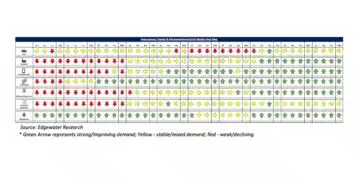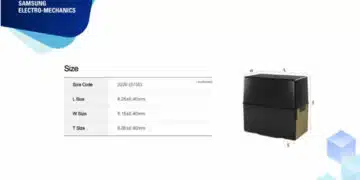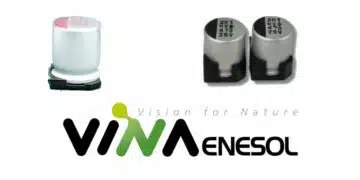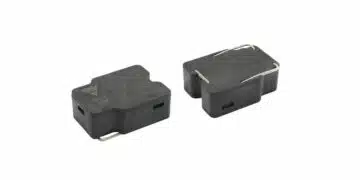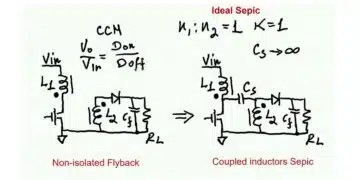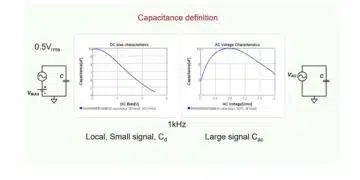source: Nichicon article
NICHICON announces a new capacitor that will contribute to these IoT systems as the market for home and industrial monitoring expands with the use of surveillance cameras and home appliances.
There is a growing expectation of consumers to be connected to everything they use on a daily basis. This is come to be known as the IoT. Items that were not previously connected to the internet, such as vehicles, home appliances, electric power meters, industrial machinery and infrastructure, factory manufacturing equipment and even wearable are being connected using telecommunication and networking systems. This is leveraging interoperability with other devices to create new products and services using big data.
Development of Electric Double Layer Capacitors for the IoT Market
Wearables are devices like: eyeware that is equipped with a camera, smart watches, or fitness trackers that are worn on the wrist, all offering groundbreaking desings and hands free convenience. Wearables must be small, thus there are limits to the size and shape of the storage batteries used in these devices. For example, flexible thin electric double layer capacitors (EDLC’s) are used in wristbands, and ultrafine electric double layer capacitors are used in eyeglass frames. Designs are expected to continue adapting to various shapes going forward.
Amid these market developments, NICHICON has developed the ultrafine electric double layer capacitor. Until now, the φ6.3×9L(mm) size had a maximum 1F storage capacity. We have successfully developed an ultrafine electric double layer capacitor with the same storage capacity (1F) in a φ4×30L(mm) size through the development of high capacity electrodes, as well as the development of production technologies with improved precision. This is ideal for thin products such as smart eyewear and stylus pens. They also have the added capability of being able to be charged even with a very low current, which is expected to encourage the spread of this technology to applications in areas such as energy harvesting.
![]()
Ultrafine electric double layer capacitors
Long-Life, Compact, Low Impedance Radial Lead Type Aluminum Electrolytic Capacitors
Electric power meters and sensor modules transmit information using telecommunications. As information transmissions become more frequent, electric power increases. Low impedance capacitors are required to suppress electric power consumption. Furthermore, there is a growing demand for smaller module sizes as well as increasingly longer periods of continuous usage. NICHICON expanded its lineup, adding the newly rated UHW series of long-life, compact, low impedance radial lead type aluminum electrolytic capacitors. These products achieve high performance through the use of high capacity electrolytic foil and the development of new electrolytes aimed at low impedance and longer life.
![]()
Long-life, compact, low impedance radial lead type
aluminum electrolytic capacitors
Development of Conductive Polymer Hybrid Aluminum Electrolytic Capacitors
Aluminum electrolytic capacitors are small sized, large capacity and low cost components used in a variety of electronic products. Electrolytes are used for aluminum electrolytic capacitor cathode materials, realizing low leakage current due to the high reparability of the electrolyte dielectric oxide film. However, electrolytes are ion conductive, with higher resistance than conductive polymer, and are susceptible to the influence of environmental temperatures, such as the increase of ESR in low temperature regions and the accelerated evaporation of electrolytes in high temperature regions.
On the other hand, conductive polymer aluminum solid electrolytic capacitors use conductive polymers for cathode materials, which enable support for low resistance and high ripple current, as conductive polymer is electron conductive. Also, there is minimal change in characteristics due to temperature and no dry up, enabling long life and usage in a variety of temperature regions. However, compared to electrolytes, conductive polymers have low electrolyte dielectric oxide film reparability, thus it was difficult to use in applications requiring low leakage current.
NICHICON developed the GYA series of conductive polymer hybrid aluminum electrolytic capacitors (guaranteed for 4,000 hours at 125°C) to leverage both these advantages while compensating for the drawbacks of the above mentioned capacitors. This capacitor uses a hybrid electrolyte solution combining conductive polymer and electrolytes realizing long life and low leakage current characteristics due to the low ESR characteristics of conductive polymer and electrolytes and the use of a newly developed electrolytic solution compatible with conductive polymer. The use of conductive polymer also enables a longer life, enabling use in a variety of applications, including vehicles, power sources, telecommunications equipment, home appliances and light fixtures.
Going forward, we think the market will continue to grow amid expanding conductive polymer hybrid aluminum electrolytic capacitor usage applications. NICHICON plans to expand its lineup of high-performance conductive polymer hybrid aluminum electrolytic capacitors to respond to demands for enhanced storage capacity, higher heat tolerance, lower resistance, longer life and higher voltagewithstanding.
![]()
GYA series of conductive polymer hybrid aluminum electrolytic capacitors
![]()
Conductive polymer hybrid aluminum electrolytic capacitor and
aluminum electrolytic capacitor frequency and temperature characteristics


